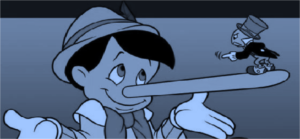The Point: If you deal with salespeople, or anyone in the workplace, you know that they have probably at some point lied to you in order to persuade you/your team to take action they desire. In this post, we’ll explore how to deal effectively with liars in the workplace as well as 5 tips to overcome their lying ways… Enjoy!
Liar, Liar, Pants on Fire!
A prominent study found that people on average lie one to two times daily. What? Who are these people? They must not be someone that I work with… hopefully!
When it comes to dealing with people in business, the same study found that roughly half of those engaged in negotiations will result to lying in order to get their way (read that as opportunity + motive=lying).
So what’s the answer? Most leaders will claim to have “Lie Detectors” (or “BS Detectors”) that through their years of experience, EQ+IQ, and just plain old detection abilities lead them to sniff out such lies. Unfortunately, this rarely happens, and the reasons abound for the nearly 50/50 chance at guessing whether or not a lie is happening (That’s the same odds as a coin flip!)
Lying… The Choice of a New Generation
So what can the leader do to better equip themselves so as to diminish the lying experience associated with business? The following are 5 tips to overcome the leadership challenge of lying:
Tip #5 – Reciprocate Transparency
Share your positions with others regarding intentions and/or what you have in mind, and set expectations regarding what you’d like to have in return. The act of setting expectations in a clear/concise manner results in higher outcomes where parties reciprocate transparency.
Tip #4 – Interview Expectations
You’ve properly established what your expectations are, but do you follow-through in conversations or interviews regarding what the other party intends through indentifying their expectations? When conducting such interviews, insure that your questions hit those expectation moments so as to identify whether or not the other party is on the same page with you.
Tip #3 – No Ducking
When conducting said interviews, make certain that you can identify moments where the other party is attempting to “duck” or dodge your question by not answering it. There can be no ducking when answering, because ducking leads to lying!
Tip #2 – Confidential Retribution
A study conducted found that the more a survey stresses the confidential nature of the answers providing anonymity of respondent, the more said respondent felt threatened by providing damning data (and therefore hedged or “ducked” their answers!)
Tip #1 – Hack for Results
With tight lips, there are no sinking of ships… However, today’s version of this classic WWII saying comes with the internet. The internet is where information abounds, so do your homework by hacking different sites to acquire information needed to make best decisions. You may even consider interviewing affiliated resources (i.e., people) to see what information they can share (like through LinkedIn’s “InMail” feature).
SUMMARY
In this post we’ve examined the leadership challenge of lying and provided 5 tips for dealing effectively with a liar as a leader. While you may never be able to extinguish lying in the workplace, you should look to diminish the impact that it has on you/your organizations dealings.
Sam Palazzolo




